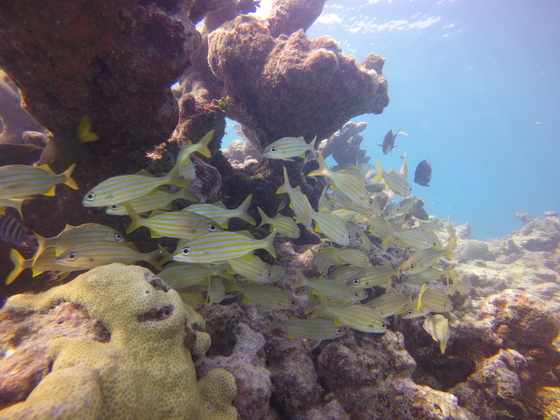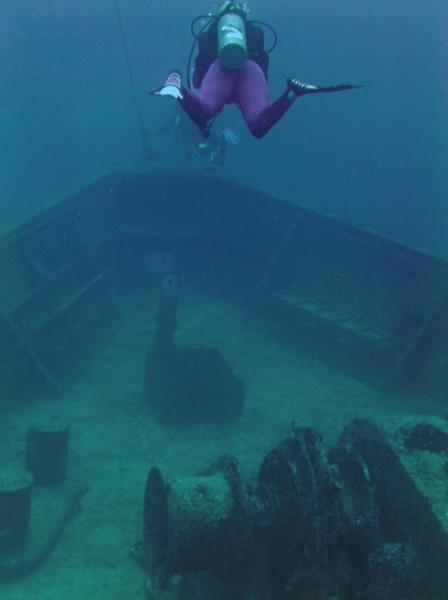![]()
- Coral Restoration Foundation
- Archaeological Diving Experience
- M. V. Benwood Wreck
- ADA Divers Savor Annual Key West Weekend
- The In’s and Out’s of Penetration
- Dive Gear I Want to See Invented
- Big Fish, And Their Waste, Are Key Parts of Coral Reef Ecosystems
- Diver's Safety Sausage - Part 2
- How did the BP spill affect Florida?
- ADA Post Dive BBQs
- Become a CRF Citizen Scientist
- Dive Cruise Update
- Newsletter Delivery Options
- Email or Address Change?
- T-Shirts For Sale
- ADA Guidelines and Policies
Time Is Running Out To Join the Coral Restoration Foundation Coral Planting Experience
 The Active Divers
Association is hosting a joint coral restoration event
on Saturday, September 17. Join us and the Coral
Restoration Foundation (CRF) for an educational and
fulfilling volunteer experience learning how to
prepare, grow, harvest, and replant corals on our reef
eco-system. This full day program includes classroom
training in the morning, followed by a catered lunch,
and a two-tank dive trip visiting the CRF coral
nursery, and out-planting baby corals onto the reefs.
Cost is $130 per diver and includes 2016 membership in
the Active Divers Association (required), all diving,
tanks/weights, lunch, CRF donation, boat fees, and
materials. The deadline for registration is September
6. Click here
to see the lead story on our home page.
The Active Divers
Association is hosting a joint coral restoration event
on Saturday, September 17. Join us and the Coral
Restoration Foundation (CRF) for an educational and
fulfilling volunteer experience learning how to
prepare, grow, harvest, and replant corals on our reef
eco-system. This full day program includes classroom
training in the morning, followed by a catered lunch,
and a two-tank dive trip visiting the CRF coral
nursery, and out-planting baby corals onto the reefs.
Cost is $130 per diver and includes 2016 membership in
the Active Divers Association (required), all diving,
tanks/weights, lunch, CRF donation, boat fees, and
materials. The deadline for registration is September
6. Click here
to see the lead story on our home page.
Learn more about the experience and sign up today. For questions, contact Lon at lon@diverlon.com or 305-251-4975.
![]()
Join ADA For Our First Archaeological Diving Experience
--by Rachel Davis, John Davis, and Lon Von Lintel
ADA has partnered with the Florida Public
Archaeological Network (FPAN) to present our First
Annual Underwater Spanish Wreck Diving Weekend. The
Florida Public Archaeology Network, FPAN, is a
statewide network with regional centers dedicated to
public outreach and assisting local governments and
the Florida Division of Historical Resources, in order
to promote the stewardship and protection of Florida’s
archaeological resources. Through creating and
developing partnerships, FPAN strives to engage the
public with Florida’s rich archaeological history.
For divers with a romantic spirit, an inquisitive nature, or an appreciation of history, there is nothing quite like exploring a sunken Spanish Galleon in the Florida Keys! ADA is proud to offer this unique opportunity to learn and explore a living piece of our history.
Here are the details: Who: ADA members interested in learning about and diving on Spanish wrecks. What: 2-1/2 day course of classroom, pool training, and Spanish wreck diving. When: September 9-11, 2016 Where: Upper Florida Keys (Key Largo and Tavernier) Cost: $199 per diver includes classroom training fees, boat fees, pool fees, recording and mapping and photography equipment and tools. Free 2016 ADA membership included for those not already members. Not included - scuba equipment and tanks (can be rented from Capt. Slates), meals, and lodging.
![]()
The Benwood lies on a sandy bottom, its stern rests at a depth of 25 feet and its bow rests at 45 feet. The majority of the ship is almost completely submerged within the sandy bottom with the exception of its ribs. The ribs are homes and nurseries to an abundant array of reef fish. The bow rises free from the sand, exposing an amazing backdrop for photographers. The ship can be located oceanside off Key Largo near Molasses Reef at 25.0524° N, 80.3323° W.
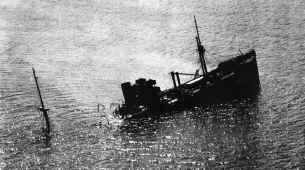 The MV Benwood, built
in1910, is an English cargo vessel that was owned by a
Norwegian company and registered as a merchant marine
freighter. She was 360 feet long. On April 9, 1942,
she was unarmed, transporting phosphate rock from
Tampa, Florida to Norfolk, Virginia. In fear of enemy
attack, ships would run at night without lights. That
morning, around 1:30 a.m. the Benwood crew spotted the
Robert C. Tuttle, an American freighter also running
without lights at its starboard bow. The collision was
unpreventable and disastrous, crushing the Benwood’s
bow. The collision started the flooding of the
Benwood. In an attempt to save the ship, crew, and
cargo, the captain turned her towards the Key Largo
lights. The vessels’ flooding was eventually
unsustainable, so he ran her aground on the reef where
she currently lies. The Benwood crew abandoned ship
and all but two crewmen reached safely to the Tuttle
vessel. The Tuttle sustained minimal damage and
traveled within the darkness to safety. The Benwood
sank at its current location and was undisturbed until
the 1950’s where the U.S. military utilized its
exposed superstructure as target practice. Still
posing a navigation hazard, the superstructure and
sections of the vessel were detonated.
The MV Benwood, built
in1910, is an English cargo vessel that was owned by a
Norwegian company and registered as a merchant marine
freighter. She was 360 feet long. On April 9, 1942,
she was unarmed, transporting phosphate rock from
Tampa, Florida to Norfolk, Virginia. In fear of enemy
attack, ships would run at night without lights. That
morning, around 1:30 a.m. the Benwood crew spotted the
Robert C. Tuttle, an American freighter also running
without lights at its starboard bow. The collision was
unpreventable and disastrous, crushing the Benwood’s
bow. The collision started the flooding of the
Benwood. In an attempt to save the ship, crew, and
cargo, the captain turned her towards the Key Largo
lights. The vessels’ flooding was eventually
unsustainable, so he ran her aground on the reef where
she currently lies. The Benwood crew abandoned ship
and all but two crewmen reached safely to the Tuttle
vessel. The Tuttle sustained minimal damage and
traveled within the darkness to safety. The Benwood
sank at its current location and was undisturbed until
the 1950’s where the U.S. military utilized its
exposed superstructure as target practice. Still
posing a navigation hazard, the superstructure and
sections of the vessel were detonated.
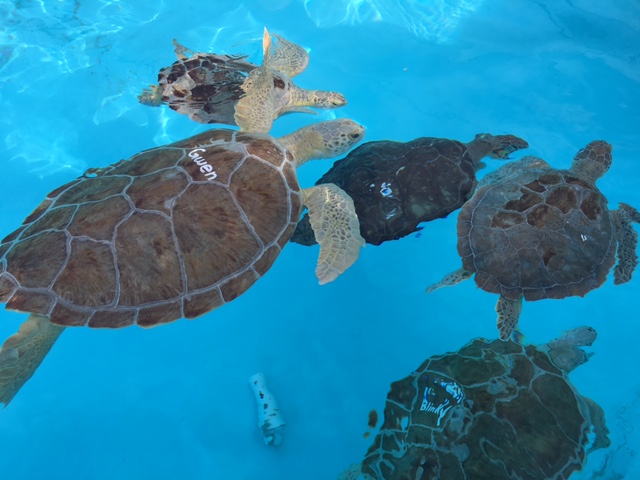
Our boat trip out of Looe Key resort on Saturday was
cancelled due to mechanical failure, so we were
rebooked on Lost Reef Adventures charters to dive the
reefs of Key West. I had not heard great things about
Key West reefs, but was very impressed with the reefs
and conditions. The first dive was on the Haystacks,
which are towering reef mounds with plenty of fish
underneath. Conditions were excellent with seas less
than a foot. On the second Key 

The ADA Key West weekend is in its second year, and it is sure to be an annual staple on the dive schedule. Don't miss out and join us in Key West in 2017.
![]()

Now, now, behave yourself. We are going to take a look at the debate over ship wreck penetration by advanced divers. From the beginning you need to know that the Active Divers Association has not issued an official position on wreck penetration, but safety is always our first concern. Keep in mind that most dive operators restrict wreck penetration to the “light zone only”. Like cave and cavern diving, wreck penetration can be rewarding to some divers, but comes with a list of safety concerns and requires proper training and equipment.
Ship wrecks are fascinating. They are underwater historical museums and monuments. Whether sunk intentionally, by acts of war or God, each wreck has a story to tell. Additionally, wrecks are often in deep clear water and attract an enormous variety of marine life, including species that may not be common on a shallow reef, especially large pelagic fish. Additionally, wrecks are full of sharp edges and open and closed spaces that can be very picturesque and beg to be explored. This makes wreck diving very exciting for a properly trained diver, but very dangerous for an improperly trained or untrained diver.
Wreck diving is generally divided into three categories, each of which have different safety concerns and require different levels of training1:
![]()
 Like many of our longtime
ADA members, I have been diving since Lloyd Bridges
was using a double-hose regulator and a BC was a vest
in front. To many of us, almost all dive gear is a new
invention from our early diving days. But only rarely
does a new product come along to really make some part
of diving easier or more fun. Although I don’t use
them, weight-integrated BCs as well as combination
BC-inflator/octopus rigs are some examples of new
and/or improved technologies that have come along
since I started diving, and some people find them
better than the old way of doing things.
Like many of our longtime
ADA members, I have been diving since Lloyd Bridges
was using a double-hose regulator and a BC was a vest
in front. To many of us, almost all dive gear is a new
invention from our early diving days. But only rarely
does a new product come along to really make some part
of diving easier or more fun. Although I don’t use
them, weight-integrated BCs as well as combination
BC-inflator/octopus rigs are some examples of new
and/or improved technologies that have come along
since I started diving, and some people find them
better than the old way of doing things.
There were no dive computers when I became certified, and I just recently bought my second one ever. I am slow to change. But the only way new dive gear will come along is if we think of things that could make the diving experience more enjoyable, and turn that into a product idea. I propose that this be the first of a regular series in the Mouthpiece: Dive Gear I Want to See Invented.
![]()
The Nassau grouper, pictured center with stripes, is one of the larger fish that lives around coral reefs. Photo: Craig Layman, North Carolina State University Coral reefs wouldn't be the same without their beautiful fish.
A diversity of colorful, beautifully patterned
species lives in tandem with coral reefs around the
world, having adapted their appearance, body structure
and lifestyle to take refuge in the folds of spiny,
spongy, slippery reefs.
Recent studies suggest that coral reefs, however, are just as dependent on these fish for key nutrients that help coral grow. When fish urinate, they release phosphorus into the water. This phosphorus, along with nitrogen excreted as ammonium through the gills of fish, is crucial to the survival and growth of coral reefs.
A new study appearing Aug. 16 in Nature Communications takes this a step further, finding that in coral reefs where fishing occurs, nearly half of these key nutrients are absent from the ecosystem.
![]()
Become A Coral Restoration Foundation Citizen Scientist
About Citizen Science
In the scientific world, data is the backbone of many
projects that help to inform future conservation
management plans and operations. Monitoring projects
can help to assess changes in the environment overtime
and are very useful in 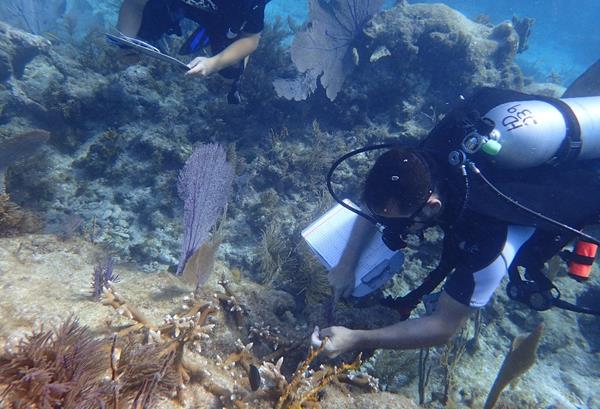 creating regulations
and management plans for the ecosystem of concern.
Being able to sufficiently address questions related
to management and conservation requires access to a
very large collection of data. With limited funding
and resources stretched thin, the ability to collect
this large database can be difficult for scientists
and field assistants alone. In response to this
scarcity of resources, citizen science projects have
been created around the world to help gather data and
monitor the health of ecosystems and populations.
Local volunteers and visiting conservation enthusiasts
can become engaged in the local data collection for
organizations.
creating regulations
and management plans for the ecosystem of concern.
Being able to sufficiently address questions related
to management and conservation requires access to a
very large collection of data. With limited funding
and resources stretched thin, the ability to collect
this large database can be difficult for scientists
and field assistants alone. In response to this
scarcity of resources, citizen science projects have
been created around the world to help gather data and
monitor the health of ecosystems and populations.
Local volunteers and visiting conservation enthusiasts
can become engaged in the local data collection for
organizations.
![]()
We reviewed the basic tube, use, and purpose in Part 1. Now, let's take a look at several methods and mechanisms used to inflate the tube.
- The simplest is the open-end tube. It can be inflated by mouth or by purging the second stage of the regulator into the opening. But it lacks any method of closing the opening other than holding by hand. One advantage is that a light can be inserted, illuminating the tube at night. I used this type one night in the Red Sea, and the boat crew reported it could be seen almost a mile away.
- The next is an oral inflator valve. It has a one-way valve that will prevent air from escaping once the tube is inflated. This is the most common type and easy to use. A chemical light could be attached to the tube for night diving.
- Another is the BCD inflator, which uses a connecter that can be attached to the low-pressure inflator hose. But it is expensive and requires disconnecting the hose from the BCD, which in some situations may not be desirable or advisable.
As noted in Part 1, the purpose of the Safety Sausage is to be seen on the surface. Another simple device which I have used, is the signal mirror. It can be used in
![]()
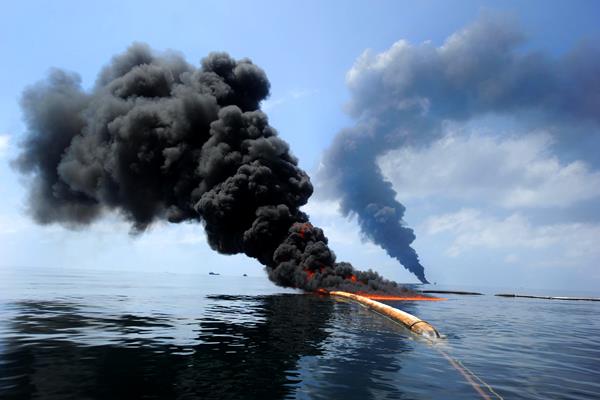
On April 16, 2016, the Deepwater Horizon oil rig exploded, killing 11 workers and sinking the Deepwater Horizon drilling platform some 1,300 feet in the Gulf of Mexico. The disaster, otherwise known as the BP Oil Spill, continued spewing oil for 87 days, giving it the dubious title of the largest accidental marine oil spill in history. Six years later, the effects are still being felt. What happened on the east coast? Nada! But on the west coast it did considerable damage. Turns out that maybe we want to make a special visit to Collier County and dive there. Yes, you read that correctly. You see, they received $1.3 million from the settlement from BP for the 2010 Deepwater Horizon oil spill. With those funds as seed money, they are doing something for scuba diving.
A total of 36 artificial reefs will be constructed, ranging from 10 to 28 miles from shore. They will be located in 40 to 75 feet of water. Hmmmm.... Good for all us divers. I never dove there, so I am wondering what about dive boats and scuba-related infrastructiure? Is there any? I’m sure there must be a few, but I have never heard or read about any diving in this area. Sounds like it may be worth a trip to see.
Ultimately, it will consist of concrete, culverts and similar materials.. Say isn’t that a lot like a spot off of Miami?
(To see the trailer for the September release of the docu-drama Deepwater Horizon, click here.)
ADA Post Dive BBQs - Wonderful
Lee and Rosy Wood have been the most gracious and accommodating hosts, welcoming ADA to their beautiful water view home in the Fabulous Florida Keys. Located just 4 blocks from the Florida Keys Dive Center, we all assembled quickly after the dive on Saturday, August 20. Relaxing on the second story screened deck and watching the sunset over Florida Bay, we were then treated to Lenora's luscious menu of salmon, hamburgers, hot dogs, several different salads, chips and salsa. Then, back to the dive shop for a memorable night dive. In all, the following attended the BBQ: Lee and Rosy Wood, John and Rachel Davis, Lon Von Lintel, Connie Cox, Lenora Bach, Roger Bach, Jeff Roth, LeAndriah and Andrew Strom, Denise Tucker, Eugenio Bo, Mike Ewanus, Jay Abbazia, Stefano Barbosa, and Thomas Rodriques
Here's a special shout-out and thanks to LEE, ROSY, AND LENORA: WELL DONE ! !
It’s hard to believe, but the November 13th Dive cruise is just a few months away. While I would like to encourage more divers to join us, I can’t, because ALL OF THE DIVE EXCURSIONS ARE SOLD OUT!!! So once again, the early bird gets the worm for two reasons: If you book when we announce the trip you will get the lowest prices on the excursions, and you can always cancel if you change your mind later, but you can’t add excursions that are full!!! So next year, if you are even remotely considering the trip, you should go ahead and book it since you can cancel without penalty up to 76 days ahead of the sailing.
By booking with ADA, if a problem arises we have some leverage. For example, the cruise ship cancelled the Belize City dive, but we were able to book a local operator for the club dive at a lower rate than the ship had offered.
Looking forward to seeing you onboard!!!
Daryl and Dan
Show your pride in the best dive club anywhere! Sizes small, medium, large, xlarge, xxlarge. Some tank tops available also. All shirts are $10 each. CALL LON AT 305-251-4975 AND PLACE YOUR ORDER TODAY!. Lon will deliver it to you on your next dive

Want your newsletter delivered via snail-mail? Contact the webmaster and request a printed copy. Be sure to put "ADA Newsletter" in the subject.
![]()
If so, please email or call us with your current information. you may send an email to: Dr. Dan Baeza, Membership Chair at dmbaeza@bellsouth.net. You can also call Dan at 954-260-8225 and leave a message with your new contact information.

![]()
